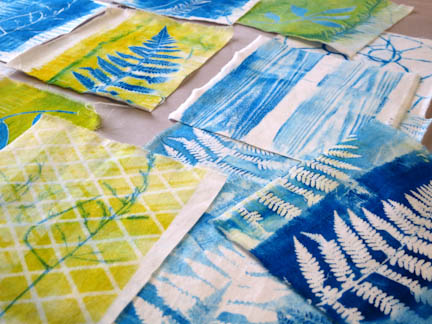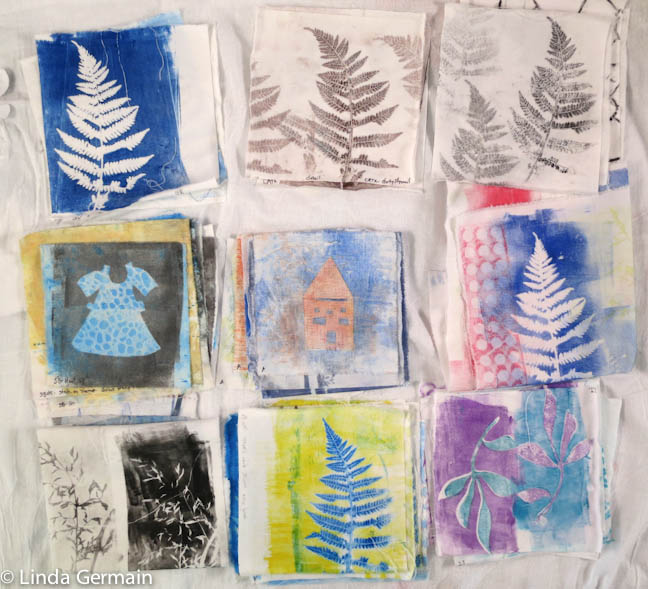A summary of inks for monoprinting on fabric with the glycerin and gelatin plate

I have been printing with different inks on cotton fabric to find the one that works best for my application. I have tried:
- Speedball water soluble block printing inks – water based
- Speedball Screen printing fabric ink –
- Speedball Fabric block printing ink – oil based water soluble
- Versatex Screen printing ink for fabric and paper
- Jaquard Textile Color
- Pro Chemical textile paint
- Createx Acrylic Colors – screen print or brush
- Createx Monotype colors
- Acrylic Craft Paint
- Caligo Safe Wash relief ink
- Aqua Linoprint by Schmincke
- Daniel Smith Water Soluble Block Printing inks
- Golden Open Acrylics
Many of these inks are not intended for use on fabric, but I had them around and wanted to see what would happen if I used them to print on fabric.
You know that I believe, “Fearless experimentation can lead to extraordinary results.”
The perfect ink for my application will:
- roll out thin layer with brayer
- hold the edge of a detailed mark
- print very dark to very light
- stay alive/workable as long as possible
- non-toxic and low fumes
- dry fixed on the fabric
- allow fabric to remain soft and supple
Often is it not possible to do a quick test of inks when printmaking. Printmaking takes time and often the first few prints with a new ink are not so great. Each ink has a learning curve. What is good for one person may not work for another person.
You can make one change –
- type of fabric,
- type of plate,
- weather and
- speed of working and it could affect your results.
So these are just my opinions based on one or two weeks of test printing on fabric. Please do your own tests with your own goals and desires.
As you can see from the picture below, it is possible to get a pretty good print from most of the inks that I tried. Please note that I was working small and fast and doing the most I could to get a strong print.

Here is a very short summary of my experience with these inks for printing on fabric with the gelatin plate.
- Speedball water soluble block printing inks – water based- I printed on damp fabric and did a very quick dry/heat set with iron. May not be permanent.
- Speedball Screen printing fabric ink – Ok but did not roll out as smooth as the Versatex
- Speedbal Fabric block printing ink – oil based water soluble – I am sensitive to the oil base. Takes practice to get it to work with the water based gelatin plate
- Versatex Screen printing ink for fabric and paper – My choice – It meets all my criteria above
- Jaquard Textile Color – Second choice – it is a little too fluid, so it loses details.
- Pro Chemical textile paint – may be a good choice but mine was too old. Give yourself a chance – don’t use old dried up inks
- Createx Acrylic Colors – screen print or brush – Pretty good but coverage was uneven
- Createx Monotype colors – Good but I am not sure if it is permanent
- Acrylic Craft Paint – Not so good, stiff, dries very fast, sticks to the plate, but it is cheap and readily available.
- Caligo Safe Wash relief ink – water soluble oil – did not roll up very evenly for me
- Aqua Linoprint by Schmincke – water soluble oil – stuck to the plate and did not release on to the fabric
- Daniel Smith Water Soluble Book Printing inks – water soluble oil – requires time to get to know the ink – pretty good coverage, but I hear they are discontinuing the product
- Golden Open Acrylics – stuck to the plate and did not want to release on to the fabric, for that reason it was hard on the gelatin plate. I have seen it work for others using the commercial gel plate.
If you would like to explore this monoprinting on fabric process with me and a group of international artists, then sign up today for Make Monotypes- the printing on fabric edition.